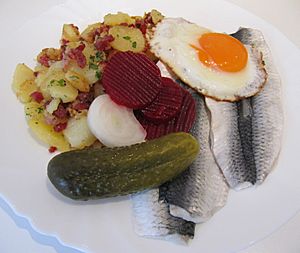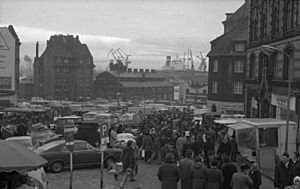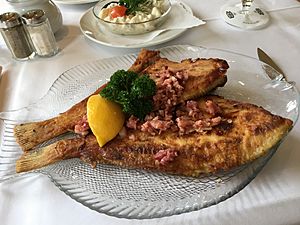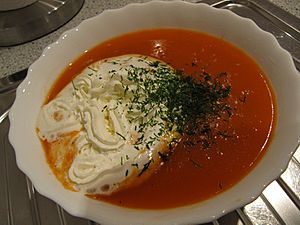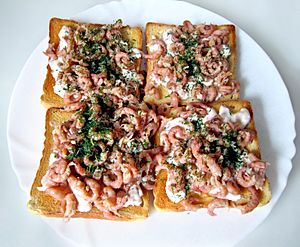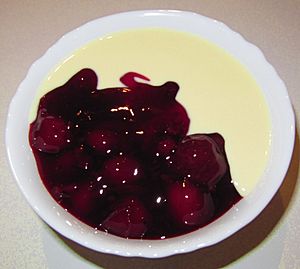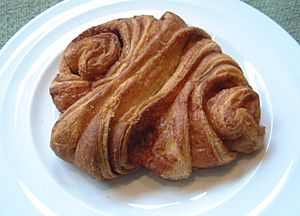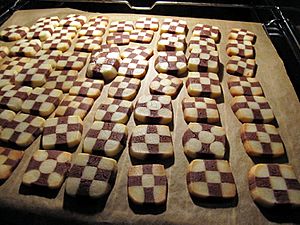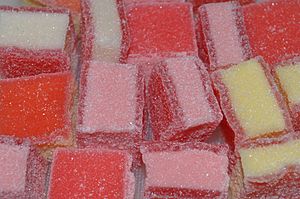Cuisine of Hamburg facts for kids
Hamburg is a famous port city in Germany. Its food is very diverse and tasty. This is because ships brought many different ingredients for centuries.
For a long time, Hamburg's food was mostly about fish. Fish came from the Elbe river and the nearby Baltic Sea. Fresh vegetables came from the Vierlande region. Fruit grew in the Altes Land area. The Wilhelmsburg area was known as Hamburg's 'milk island'.
Since the 1500s, trade through the Port of Hamburg brought spices and new foods from India and South America. These new ingredients quickly became part of local cooking. Today, some old Hamburg food traditions have changed. This is because food styles across North Germany have become more similar. However, Hamburg still has many top-rated restaurants. In 2010, 11 of them earned a special Michelin star award.
Contents
History of Hamburg's Food
Hamburg has always been a big trading city. This meant that wealthy merchants lived there. It also meant many goods from around the world were available. In rich homes, kitchens were often in the back. They had a 'splendor kitchen' to show off fancy tableware. The 'work kitchen' was where the actual cooking happened.
Poor families in Hamburg had different kitchens. They often did not have separate cooking areas. Firewood was expensive, so ovens were not used much. Hot meals were rare. If they cooked, it was usually a stew.
There is a famous story about salmon. It says that Hamburg had so much salmon that even poor people got tired of eating it. The city council supposedly made a rule. It said that masters could not give salmon to their servants more than twice a week. This story is just a legend. But it is true that salmon was very common in the 1800s.
Local Dishes of Hamburg
Fish Dishes
Because Hamburg is on the Elbe river and near the sea, it has many fish dishes. You can find different herring dishes. These include Matjes (young herring) or Bismarckhering (pickled herring). Fresh herring, called 'Green Herring', is also popular. A fried herring becomes a Brathering if it is soaked in vinegar.
Another famous fish dish is Räucheraal, which is smoked eel. It was sold by street vendors in the early 1800s. Many local restaurants also served it. The dish Finkenwerder Scholle (plaice from Finkenwerder) is a Hamburg specialty. Pannfisch is another typical dish. It uses leftover fish in a mustard sauce, served with baked potatoes. Carp is often eaten for Christmas dinner or on New Year's Eve. The Fischbrötchen is a popular street food. It is a roll with raw or fried fish inside.
Soups and Stews
One very popular soup in Hamburg is Hamburger Hummersuppe. This is a creamy lobster soup. It is served with a little whipped cream and dill. A similar soup is Hamburger Krabbensuppe, made with small shrimp. Some people like to add a bit of Cognac to these soups.
The Hamburg version of Steckrübeneintopf (rutabaga stew) is called 'Hamburger National'. Other stews include Birnen, Bohnen und Speck (pears, beans, and bacon), Labskaus, and Hamburger Aalsuppe. Hamburger Aalsuppe is a vegetable stew with root and green vegetables, plus dried fruit. There is a debate about whether it should have eel or not. But the version without eel is usually seen as not the original.
Snack Foods
Like in any big city, Hamburg has many snacks. Besides international foods like Doner Kebab, Asian dishes, or pizza, there are local snacks. Fish sandwiches, or Fischbrötchen, are very popular. Krabbentoast is also a favorite. It is toasted white bread with small, brown shrimps from the North Sea. People eat it for breakfast or as a lunch snack. Other popular snacks are Currywurst (sausage with curry sauce) and Knackwurst.
Main Dishes
One main dish from Hamburg's wealthier kitchens came from trade with Portugal. It is oxtail in Madeira wine. Today, it is often served as a soup course instead of a main dish. Other important dishes include Schwarzsauer (a sour blood soup) and Himmel, Erde und Hölle (Heaven, Earth, and Hell).
Poultry dishes with chicken, duck, and goose are also common. 'Stubenküken' is a special dish using young spring chickens. Like in all of North Germany, kale is very popular in Hamburg's dishes. You can find it in famous meals like Grünkohl (kale stew) or Kohlrouladen (cabbage rolls) with Wirsing (savoy cabbage).
Desserts
Typical sweet treats in Hamburg include Rote Grütze. This is a red berry pudding served with milk, vanilla sauce, vanilla ice cream, or cream. Other desserts are Fliederbeersuppe (elderberry soup), Großer Hans (a flour dumpling with cherry compote), and bread pudding with lemon sauce.
Baked Goods
Hamburg's original bread roll is called "Rundstück" (round piece). If these rolls are not eaten for breakfast, they are served for lunch. They are topped with slices of roasted pork and covered in sauce. Then they are called "Rundstück warm" (warm round piece).
A famous bread is Schwarzbrot, a dark, fluffy whole wheat bread. For tea time, or 'coffee and cake' as it is called in Germany, Kopenhagener pastries are served. These are filled with jam or marzipan. Another popular baked good for 'coffee and cake' is the traditional Hamburg apple pie. The apples are pan-fried and then mixed with white wine before baking the cake.
"Black and white cookies" are also popular in Hamburg. You can buy them or make them at home. Franzbrötchen are very popular too. Despite the name, it is not a roll. It is a flaky pastry typical only for Hamburg, made with lots of butter and cinnamon. Locals enjoy it for breakfast.
Around Christmas, there is Klöben. This is a bread-shaped pastry made from yeast dough with raisins. 'Braune Kuchen' (brown cakes) are crisp, rectangular biscuits. They are made with molasses and gingerbread spice. The recipe dates back to 1782. 'Weiße Kuchen' (white cakes) are a type of fried dough. The Heißwecken (hot rolls) are yeast dough products with raisins. They are dusted with confectioner's sugar and filled with cream. People traditionally eat them during lent.
Candy and Sweets
Hamburger Speck is a type of candy made from foamed sugar with different coatings. Its colors often match Hamburg's colors: red, white, and red. The name comes from its similarity to bacon (or speck).
Drinks in Hamburg
Beer
People have brewed beer in Hamburg since the early 1300s. In 1375, there were 457 breweries! About 270 of them even exported beer. They made about 170,000 hectoliters (a hectoliter is 100 liters) each year. Over the next centuries, beer exports grew because the quality improved. More wheat beer was made, and less dark beer and red ale.
The beer recipes were kept secret. During the time of the Hanseatic League, beer export was a big part of Hamburg's wealth. The city was known as the 'brewery of the Hanse'. In the 1500s, historical records show 600 breweries. They exported beer as far as Sweden and Russia. By the 1600s, even bock beer was exported.
In the 1700s, beer making and export slowed down. The beer market did not get better until the late 1800s. By 1890, there were only 32 breweries left. Today, only two old breweries remain: the Holsten Brewery and the Gröninger brewery.
Spirits
Until the mid-1900s, popular spirits were Köm, a northern German version of Aquavit, or Korn. Korn is made from rye or wheat. The small island of Neuwerk in the North Sea, which belongs to Hamburg, makes its own Aquavit. Trade with South America brought Rum to the city. Rum is used in Grog, a popular drink, especially among sailors.
Wine Imports
Hamburg focused on importing wines from Médoc. These wines were stored in barrels in a cool, humid climate to age. This gave them a special 'Rotspon' flavor.
Coffee and Tea Imports
Different kinds of coffee and tea became popular in Hamburg in the 1600s. People drank a lot of it. The first documented coffee house opened in 1677.
Even today, most of Germany's coffee and tea imports come through the Port of Hamburg. The different varieties are also mixed and, for coffee beans, roasted in Hamburg. Then they are sent all over Germany and other parts of continental Europe.
See also
 In Spanish: Gastronomía de Hamburgo para niños
In Spanish: Gastronomía de Hamburgo para niños


